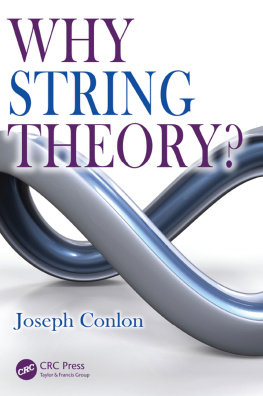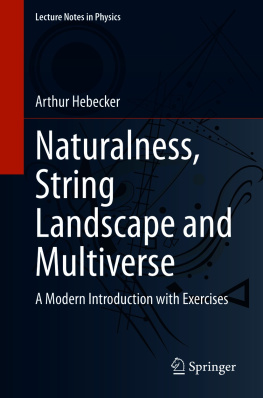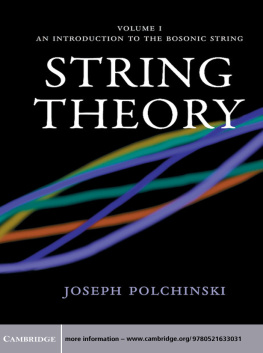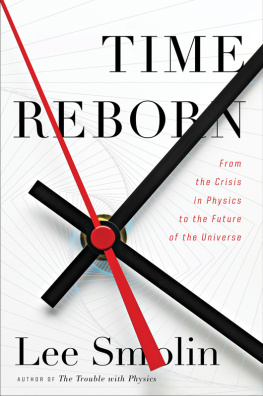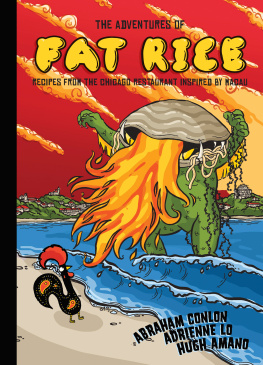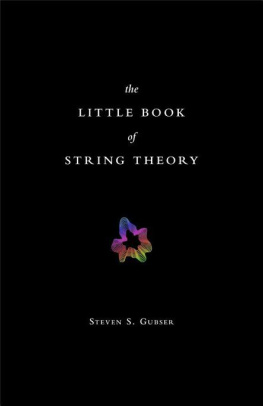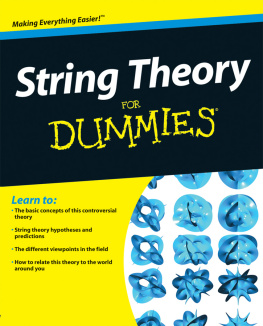Joseph Conlon - Why String Theory?
Here you can read online Joseph Conlon - Why String Theory? full text of the book (entire story) in english for free. Download pdf and epub, get meaning, cover and reviews about this ebook. publisher: CRC Press, genre: Children. Description of the work, (preface) as well as reviews are available. Best literature library LitArk.com created for fans of good reading and offers a wide selection of genres:
Romance novel
Science fiction
Adventure
Detective
Science
History
Home and family
Prose
Art
Politics
Computer
Non-fiction
Religion
Business
Children
Humor
Choose a favorite category and find really read worthwhile books. Enjoy immersion in the world of imagination, feel the emotions of the characters or learn something new for yourself, make an fascinating discovery.
- Book:Why String Theory?
- Author:
- Publisher:CRC Press
- Genre:
- Rating:4 / 5
- Favourites:Add to favourites
- Your mark:
- 80
- 1
- 2
- 3
- 4
- 5
Why String Theory?: summary, description and annotation
We offer to read an annotation, description, summary or preface (depends on what the author of the book "Why String Theory?" wrote himself). If you haven't found the necessary information about the book — write in the comments, we will try to find it.
Why String Theory? — read online for free the complete book (whole text) full work
Below is the text of the book, divided by pages. System saving the place of the last page read, allows you to conveniently read the book "Why String Theory?" online for free, without having to search again every time where you left off. Put a bookmark, and you can go to the page where you finished reading at any time.
Font size:
Interval:
Bookmark:

WHY STRING THEORY?
VST.Epub.contentReady(window, document); VST.cfiBase='/4';WHY STRING THEORY?
Joseph Conlon

CRC Press
Taylor & Francis Group
6000 Broken Sound Parkway NW, Suite 300
Boca Raton, FL 33487-2742
2016 by Joseph Conlon
CRC Press is an imprint of Taylor & Francis Group, an Informa business
No claim to original U.S. Government works
Version Date: 20151020
International Standard Book Number-13: 978-1-4822-4249-2 (eBook - PDF)
This book contains information obtained from authentic and highly regarded sources. Reasonable efforts have been made to publish reliable data and information, but the author and publisher cannot assume responsibility for the validity of all materials or the consequences of their use. The authors and publishers have attempted to trace the copyright holders of all material reproduced in this publication and apologize to copyright holders if permission to publish in this form has not been obtained. If any copyright material has not been acknowledged please write and let us know so we may rectify in any future reprint.
Except as permitted under U.S. Copyright Law, no part of this book may be reprinted, reproduced, transmitted, or utilized in any form by any electronic, mechanical, or other means, now known or hereafter invented, including photocopying, microfilming, and recording, or in any information storage or retrieval system, without written permission from the publishers.
For permission to photocopy or use material electronically from this work, please access www.copyright.com (http://www.copyright.com/) or contact the Copyright Clearance Center, Inc. (CCC), 222 Rosewood Drive, Danvers, MA 01923, 978-750-8400. CCC is a not-for-profit organization that provides licenses and registration for a variety of users. For organizations that have been granted a photocopy license by the CCC, a separate system of payment has been arranged.
Trademark Notice: Product or corporate names may be trademarks or registered trademarks, and are used only for identification and explanation without intent to infringe.
Visit the Taylor & Francis Web site at
http://www.taylorandfrancis.com
and the CRC Press Web site at
http://www.crcpress.com
VST.Epub.contentReady(window, document); VST.cfiBase='/4';To the citizens and taxpayers of the United Kingdom, without whom this book could never have been written.
VST.Epub.contentReady(window, document); VST.cfiBase='/4';Contents
VST.Epub.contentReady(window, document); VST.cfiBase='/4';Preface
This is a book about string theory. I started writing this book in 2010 with two motivations. The first was a desire to give back to those who have given to me it is an incredible privilege to be paid to think about science and fundamental physics, and those who pay the piper have a right to hear the tune. The second was an intent to heed advice passed on to me since childhood: learn as much by writing as by reading. Writing is fun, and I wanted to go beyond the technical prose of journal articles.
This book is written in response to the questions of What is string theory? and Why do you work on it then?, and it aims to answer them. String theory is, however, a large subject. Over its history, there have probably been over twenty thousand research papers on it. No one and certainly not myself! knows all of this work in detail. Writing a book requires an ordered account. In arranging material I have had to select topics, and in selecting I have aimed for the combination of intrinsic importance and personal familiarity.
To state the obvious, this is not a textbook. It does not have equations. It will not teach anyone either to do calculations in string theory or to perform research in the subject. There are many good textbooks that do precisely this, and I give references to some of them in the bibliography. What I hope the book does provide is a mental map of the subject, a tourists guide to those who want to come and see the sights before returning to their own pursuits. I also hope that it may allow those who aspire to a career in the area a chance to reconnoitre the lay of the land.
To these ends, I have aimed to describe the physics as accurately as possible consistent with the constraints. Accuracy is not a single standard. The geography of the British Isles can be accurately described either as two triangles or through a bookshelf full of Ordnance Survey maps. Neither is right or wrong; it depends on the desired level of description. I have aimed my account of string theory somewhere between these two extremes.
The book is written to be read sequentially, but this is not an absolute requirement. A reader already familiar with the big picture of known physics could skip over the first part with little loss. In the third part, on the different applications of string theory, the chapters can be read in any order. The twelfth chapter, on the different styles of scientist, stands alone by itself.
One of the joys of physics is that it is a connected subject. Ideas repeat themselves, and on occasion in this book the same idea comes up more than once. When this happens I have sometimes allowed myself to re-explain concepts rather than expect the reader to remember an explanation from a hundred pages earlier. It always takes me multiple attempts to understand any concept, and in seminars I find few things more annoying than the speaker who believes that a single mention of an idea allows them to deny the audience any further reminders or clarifications of the topic.
When quotations occur within the book, I have gathered the details of the original sources into the end-notes and bibliography. Those who require them can find them, and I wish to avoid the academic custom of battering the reader into submission through a fusillade of references to obscure journals.
Many people have helped bring this book to fruition. I should first thank those, too numerous to mention, who have helped me professionally in learning the subject over the years. I particularly thank my fellow PhD students in Cambridge from 2003 to 2006, my research collaborators, and especially my doctoral supervisor Fernando Quevedo.
In the early stages of this book a website http://whystringtheory.com was made during summer 2012, constructed by myself and two undergraduate physicists, Edward Hughes and Charlotte Mason, who are now doing PhD degrees at respectively Queen Mary University of London and the University of California at Santa Barbara. I have borrowed the title of the book from the website.
Two eyes good, many eyes better: I thank those who have read parts of this book in draft form and whose feedback has helped me both sharpen the text and remove errors of physics, grammar and style: Lucy Broomfield, Frank Close, Theresa Conlon, Marcus du Sautoy, Pedro Ferreira, Sven Krippendorf, Fernando Quevedo, Markus Rummel, Andrei Starinets, David Tong, Peter West, and particularly Thomas Conlon, David Marsh and the anonymous copyeditor. The mistakes that remain are my own.
I also want to thank both my colleagues in the Oxford physics department and the Warden, Fellows, staff and students of New College, Oxford, for providing a stimulating and inspirational environment during the writing of this book.
I thank my editor at CRC Press, Francesca McGowan, for all her hard work, unfailing enthusiasm, and her many precise and detailed emails.
Next pageFont size:
Interval:
Bookmark:
Similar books «Why String Theory?»
Look at similar books to Why String Theory?. We have selected literature similar in name and meaning in the hope of providing readers with more options to find new, interesting, not yet read works.
Discussion, reviews of the book Why String Theory? and just readers' own opinions. Leave your comments, write what you think about the work, its meaning or the main characters. Specify what exactly you liked and what you didn't like, and why you think so.

